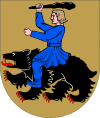Lapua
| Lapua Lappo | ||
|---|---|---|
| Town | ||
| Lapuan kaupunki | ||
|
| ||
| ||
 Location of Lapua in Finland | ||
| Coordinates: 62°58.2′N 023°00.5′E / 62.9700°N 23.0083°ECoordinates: 62°58.2′N 023°00.5′E / 62.9700°N 23.0083°E | ||
| Country | Finland | |
| Region | Southern Ostrobothnia | |
| Sub-region | Seinäjoki sub-region | |
| Charter | 1865 | |
| Market town | 1964 | |
| City rights | 1977 | |
| Government | ||
| • Town manager | Arto Lepistö | |
| Area (2011-01-01)[1] | ||
| • Total | 750.77 km2 (289.87 sq mi) | |
| • Land | 737.10 km2 (284.60 sq mi) | |
| • Water | 13.67 km2 (5.28 sq mi) | |
| Area rank | 163rd largest in Finland | |
| Population (2016-03-31)[2] | ||
| • Total | 14,628 | |
| • Rank | 79th largest in Finland | |
| • Density | 19.85/km2 (51.4/sq mi) | |
| Population by native language[3] | ||
| • Finnish | 99% (official) | |
| • Swedish | 0.1% | |
| • Others | 0.9% | |
| Population by age[4] | ||
| • 0 to 14 | 18.4% | |
| • 15 to 64 | 62.3% | |
| • 65 or older | 19.4% | |
| Time zone | EET (UTC+2) | |
| • Summer (DST) | EEST (UTC+3) | |
| Municipal tax rate[5] | 19.5% | |
| Website | www.lapua.fi | |
Lapua (Finnish: [ˈlɑpuɑ]; Swedish: Lappo) is a town and municipality of Finland.
It is located next to the Lapua River in the province of Western Finland and is part of the Southern Ostrobothnia region. The town has a population of 14,628 (31 March 2016)[2] and covers an area of 750.77 square kilometres (289.87 sq mi) of which 13.67 km2 (5.28 sq mi) is water.[1] The population density is 19.85 inhabitants per square kilometre (51.4/sq mi). The municipality is unilingually Finnish.
Events in history
The Battle of Lapua was fought between Swedish and Russian forces near the outskirts of the town on 14 July 1808 as part of the Finnish War. Lapua is the seat of the Evangelical Lutheran Diocese of Lapua. The Lapua Cathedral, designed by Carl Ludvig Engel, was built in 1827. In the 1930s the radical anti-communist Lapua Movement was founded and named after the town.
Lapua State Cartridge Factory
Lapua is also home to a large ammunition factory, which commenced operations in 1927 as the State Cartridge Factory. This factory was the primary supplier of ammunition to the Finnish Army during the Winter War and World War II. An explosion occurred in a warehouse of this factory on 13 April 1976, resulting in the deaths of 40 employees, mainly females. Sixty children lost a parent in the disaster. This is the worst accidental disaster in Finland's modern history. After the explosion, the factory was relocated 5 kilometres (3 mi) away from the town centre and continues production today as part of the Nordic Ammunition Group (Nammo) as Nammo Lapua. The original site of the factory and the surviving buildings are now an arts centre, a library and a theater.
International relations
Twin towns — Sister cities
-
 Hagfors, Sweden
Hagfors, Sweden -
 Hohenlockstedt, Germany
Hohenlockstedt, Germany -
 Lantana, Florida, United States
Lantana, Florida, United States -
 Rakvere, Estonia[7]
Rakvere, Estonia[7] -
 Kiskőrös, Hungary
Kiskőrös, Hungary
Notable persons
See also
- Lapua Movement
- Blue Highway, an international tourist route
References
- 1 2 "Area by municipality as of 1 January 2011" (PDF) (in Finnish and Swedish). Land Survey of Finland. Retrieved 9 March 2011.
- 1 2 "Ennakkoväkiluku sukupuolen mukaan alueittain, maaliskuu.2016" (in Finnish). Statistics Finland. Retrieved 31 March 2016.
- ↑ "Population according to language and the number of foreigners and land area km2 by area as of 31 December 2008". Statistics Finland's PX-Web databases. Statistics Finland. Retrieved 29 March 2009.
- ↑ "Population according to age and gender by area as of 31 December 2008". Statistics Finland's PX-Web databases. Statistics Finland. Retrieved 28 April 2009.
- ↑ "List of municipal and parish tax rates in 2011". Tax Administration of Finland. 29 November 2010. Retrieved 13 March 2011.
- ↑ "Lapua info (statistics)". Lapua. Retrieved 30 April 2014.
- ↑ "Twin Cities". Rakvere. Retrieved 30 April 2014.
External links
![]() Media related to Lapua at Wikimedia Commons
Media related to Lapua at Wikimedia Commons
- Town of Lapua – Official website
- History of Nammo Lapua Oy at lapua.com
- Lapua WebCam provided by Media-Wolf
- Vanhan Paukun Festivaali Music Festival at the Cultural Center Vanha Paukku.


